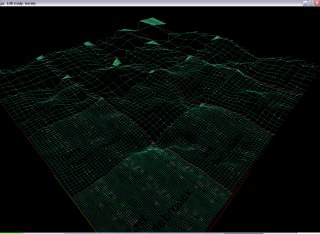I dunnit !

Finally sewed all the seams together! This screenshot shows a patch of 4x4 chunks.
features:
- - chunked LOD
- - 1 chunk = 64x64
- - 4x4 chunks
- - simple LOD algorithm (based on 2D distance from centre-of-chunk to camera, height does not count)
- - 1 single texture for every chunk (to downsize demo and because I don't have texture mgmt)
- - normally, one texture per chunk (no multi-texturing) with red edges to find chunk edges
- - direct-mode passing of all data (no display lists, no vbo)
- - 1 dynamic light, just to enhance landscape features a bit
keys:
- - arrows = navigate
- - CTRL+arrows: yaw/pitch
- - Q/W = change the height (I'm on AZERTY, so you may need to press A/Z)
- - A/Z = change FOV (same remark)
- - D = print debug, including FPS
- - T = toggle wireframe
Known issues:
- - fps is calculated based on currentTimeMillis(), and is only updated every second (to compensate for lack of accuracy)
- - popping
- - performance (init is slow, + very inefficient storage of heightmap)
- - ridiculous memory consumption
TODO:
- - compare display lists / VBO
- - geomorphing?
- - multi-texturing (will allow pre-rendered lightmap)
- - refactor my chunked code into something actually usable




